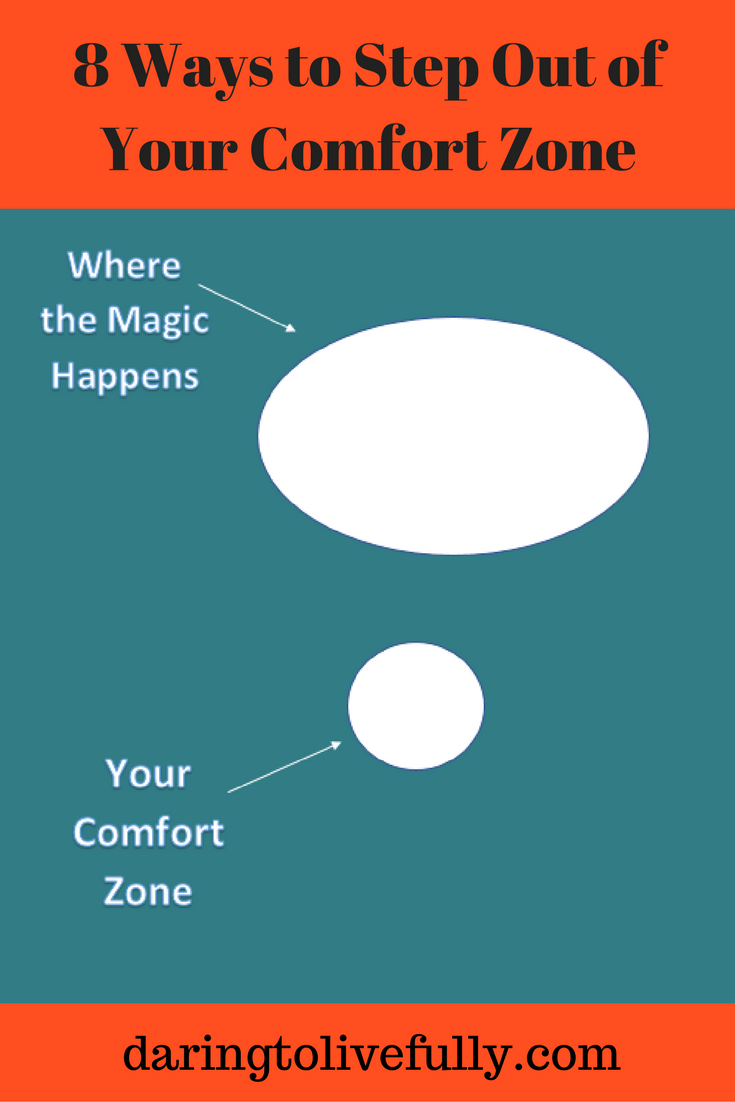
It’s time to break out of your comfort zone and get more out of life.
Most of us spend a lot of time in our comfort zone. After all, when we’re in our comfort zone we know what to do and what to expect. Here are some descriptions of “comfort zone”:
- Your “comfort zone” is a psychological, emotional, and behavioral construct.
- It’s what’s familiar to you and what feels safe—your regular habits and routines.
- When you’re in your comfort zone, you experience low levels of stress and anxiety.
- In your comfort zone, there’s little to no risk.
There’s nothing wrong with spending some time in your comfort zone. After all, we all need to take time to relax and just “be” every now and then.
The problem starts when you get too comfortable in your comfortable zone. When this happens, you stop striving to achieve your goals, you stop challenging yourself, you let opportunities slip by, and you become overly complacent.
The only way to grow, build your capabilities, and reach your full potential is by stepping outside of your comfort zone. As Neale Donald Walsh once said, “Life begins outside of your comfort zone.”
Here are some examples of things which may currently be outside of your comfort zone:

- Speaking up in class or business meetings.
- Meeting new people.
- Speaking in public and giving speeches.
- Learning new skills.
- Traveling to new places.
- Starting a new business venture.
- Taking advantage of new opportunities.
- Making changes simply to spice up your life.
In order to achieve any of these things, you need to start taking steps to break out of your comfort zone. Below I’ll share with you eight ways to escape from your comfort zone and make things happen.
1. Use Onboarding.
One way I recently stretched outside of my comfort zone was by taking a MOOC (Massive Online Open Course) on gamification. Although I’m not a video game player, I love board games. The idea of applying game elements—those elements that make games so engaging and fun—to any life area caught my attention.
I’m glad that I took the course— I learned a lot of interesting things. One of the things I liked about gamification is the concept of onboarding. Onboarding is about getting the player to take the first steps toward playing a new game. Here are some of the guidelines for the onboarding stage:
- It has to be very simple—the onboarding task has to be easy to complete.
- You want to make the player feel smart and competent.
- When a player takes the small steps necessary for onboarding, reward them.
Apply these same principles when you’re trying to step out of your comfort zone:
- Make the first step you have to take as easy as possible. As an illustration, if you want to start going to the gym, the first step you can take is simply making a list of gyms that are near your house or workplace.
- Acknowledge yourself for taking the initial step, no matter how small that step may be.
- Give yourself a reward for venturing even slightly outside of your comfort zone. This can range from giving yourself a pat on the back, to stopping by a coffee house and getting yourself a victory cappuccino.
2. Use Design Thinking.
In my post on “How to Apply Design Thinking to Your Life“, I explain that the essence of design thinking is to focus on building prototypes. That is, your goal is never to build the end-product from the get-go.
Instead, your objective is to build a prototype knowing that it’s very rudimentary. Then, get feedback; improve the product based on the feedback; and create another prototype. You continue in this way until you have something you can be proud of.
In much the same way, when you want to do something that’s outside of your comfort zone, think in terms of prototypes. As an illustration, if you want to start blogging, do the following:
- Launch a blog and write the first blog post. Publish it.
- Share the post on social media and get some feedback.
- Write another blog post incorporating some of the feedback you received.
- Get more feedback.
- Continue improving your blog posts in this way until, eventually, you have a successful blog.
3. Get Comfortable with Discomfort.
As I explained in my blog post on how to become a runner, when I was in middle school the gym teacher would make us run around the soccer field twice before each class to warm up. I would get tired and feel winded after a few minutes of running. Since I assumed that this discomfort meant that I simply wasn’t a runner, I would slow down to a walk.
Today I run 7.5 km, three times a week. How did I manage to build up to this? Because I finally understood that pushing through discomfort is how you build endurance in running. And that’s true for anything.
By definition, anything that’s not within your comfort zone is located in your discomfort zone. Every time that you step into that discomfort zone, what should you expect to feel? That’s right: you’re going to feel discomfort.
Understand that discomfort isn’t a sign that there’s something wrong. It’s a sign that you’re trying something new and different.
4. Use Progressive Loops.
In gamification, there’s something called a “boss fight”. A boss fight is an epic challenge which usually signals the end of one journey and the beginning of another one. When it comes to stepping out of your comfort zone, the final goal that you’re trying to achieve is your boss fight.
A game never starts out with a boss fight. Instead, as I said at the beginning of this post, players start out with onboarding. They then move toward the boss fight in something called progressive loops.
Progressive loops are made up of a series of small quests, each one a little more difficult than the one before. After each small quest, there’s an opportunity to rest before taking on the next small quest. Then, after the player gets progressively more skilled at playing the game by completing these small quests, they’re presented with a boss fight.
Progressive loops look as follows:

Take the same approach when it comes to stepping out of your comfort zone. Instead of tackling a huge challenge all at once, move toward it slowly by completing small challenges, each one a bit more difficult than the one before.
5. Build Your Self-Efficacy.
One of the reasons that people stay stuck in their comfort zones is because they feel that they don’t have the ability to be successful in situations outside of their comfort zone. That is, they lack the necessary self-efficacy.
As I explain in my post, How to Increase Your Self-Efficacy and Do Better in Life, there are four things you can do to boost your self-efficacy. Here are the four things you need to do in order to increase your self-efficacy so that you can break out of your comfort zone:
- Think of a time in the past when you’ve done something that was outside your comfort zone. Remind yourself that stepping outside of your comfort zone is something you’ve done successfully before.
- Look for examples of people who are similar to you who have moved beyond their comfort zones in order to accomplish their goals.
- Surround yourself with people who will encourage you to step out of your comfort zone.
- Talk yourself into escaping your comfort zone by using affirmations and reassuring, positive self-talk.
6. Create an Alter-Ego.
If even after building up your self-efficacy you still have trouble getting yourself to take those first steps outside the current boundary of your comfort zone, you may need the help of an alter-ego.
In my post, “How to Create an Alter-Ego and Why You Should”, I explain that having an alter-ego can help you to bring forth certain aspects of your personality that you normally don’t give voice to, but which can serve you well in specific situations.
Create an alter-ego. Then, allow your alter-ego to take you by the hand and lead you out of your comfort zone.
7. Draw a New Square.
Moira Geary recommends that you empower yourself to step out of your comfort zone by drawing a new square. Start by visualizing yourself inside your comfort zone, as follows:

Now, if you’re told to step out of your comfort zone, you may be hesitant to do so because you’ll basically be stepping out into an abyss. That sounds really scary. No one wants to do that.
Instead of trying to force yourself to step out into empty space, draw a new, bigger square. Like so:

Then, tell yourself that all you have to do is to step out into the slightly bigger square. Clearly identify what the new, larger square consists of. This works because, psychologically, it’s a lot easier to get yourself to step out into another clearly defined space then it is to step out into a space with no preset boundaries.
Once the bigger square becomes your new comfort zone, draw an even bigger square around that. Then, step out into the bigger square. Continue in this way and your comfort zone will grow bigger and bigger.
8. Use the 3 C’s.
Andy Molinsky, PhD, is a professor of psychology and organizational behavior at Brandeis University’s International Business School. He’s the author of Reach: A New Strategy to Help You Step Outside Your Comfort Zone, Rise to the Challenge and Build Confidence.
Molinsky explains that in his research, he’s found three tools that people use to step outside of their comfort zones successfully. He refers to these tools as the three C’s. They are as follows:
- Conviction
- Customization
- Clarity
Here’s an explanation of each one:
Conviction
Conviction is having a deep sense that taking the action that’s going to lead you out of your comfort zone is worth doing the hard work that stepping outside of your comfort zone entails. This includes knowing why taking this action is important to you.
As an example, Andy explains that doing the promotional work that’s involved with publishing a book—making public appearances, giving interviews, and so on—is outside of his comfort zone. However, he does it because he really believes that his book can help people to lead better lives.
Customization
Customizing consists of tweaking, or adjusting, how you perform a task–even if it’s just slightly– to make it feel more comfortable and natural.
As an illustration, I recently wrote a post on 7 Science-Backed Ways to Get a Quick Self-Confidence Boost. The next time you want to push yourself to speak up at a meeting, you can follow some of the tips that I wrote about in that post to feel more confident. Here are some examples:
- Wear a power suit.
- Hold a power pose before the meeting.
- Carry your lucky charm in your pocket.
That way, you’ll show up at the meeting in a way that makes you feel powerful and confident (and nobody else has to know about it).
Part of the reason that it’s scary to step out of our comfort zones is because we feel a sense of helplessness and of not being in control. You can regain some sense of control by customizing the action that you take in a way that you find empowering.
Clarity
When we have to take action that will make us step outside of our comfort zone, we can have a tendency to allow irrational thoughts to take over. You may find yourself thinking thoughts like the following:
- “This is going to be a disaster.”
- “I’m going to fall flat on my face and I’ll never hear the end of it.”
- “I’m not going to do this unless I’m sure I can do it perfectly.”
You can see how those kinds of thoughts are likely to paralyze you and keep you stuck in your comfort zone. What you need to do is to recognize that you’re having irrational thoughts, and then gain some clarity.
Clarity is developing an even-handed, reasonable perspective on the challenges you face. In other words, it’s stopping yourself from succumbing to the distorted and exaggerated thinking so many of us fall prey to in very stressful situations. Try saying things like the following to yourself:
- “Everything is going to be fine.”
- “Even if things go wrong, it’s not the end of the world.”
- “I’m not aiming for perfection. I’m just going to do the best I can.”
Conclusion
What would you do if you stopped hesitating and managed to break out of your comfort zone? Use the eight strategies I gave you above to take the first step. Live your best life by stepping out of your comfort zone.






Related Posts:




 Marelisa Fabrega is a lawyer and entrepreneur. She holds a Bachelor of Science in Business Administration from Georgetown University in Washington, D.C., as well as a Juris Doctor from the Georgetown University Law Center. You can learn more about her
Marelisa Fabrega is a lawyer and entrepreneur. She holds a Bachelor of Science in Business Administration from Georgetown University in Washington, D.C., as well as a Juris Doctor from the Georgetown University Law Center. You can learn more about her 





